
“The task is… not so much to see what no one has yet seen; but to think what nobody has yet thought, about that which everybody sees.” – Erwin Schrodinger
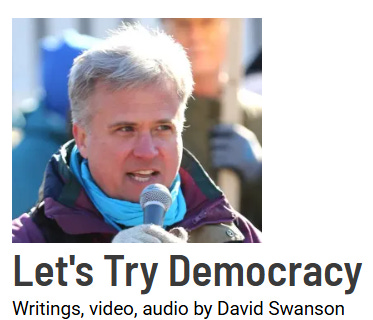
His TED Talk on how to think “against” war and for “peace” is an elevator speech worth listening to:
But you get 60 minutes with David and Paul on Paul’s Finding Fringe: Voices from the Edge. Oct. 8, but here NOW.

Ahh, the War College: [The National War College mission is to educate joint, interagency, and international leaders and warfighters by conducting a senior-level course of study in national security strategy, preparing graduates to function at the highest levels of strategic leadership in a complex, competitive, and rapidly evolving strategic environment.]

Of course, every college, university and junior college with an ROTC program, any school with a drone tech department, and now ALL tech departments are WAR Colleges.
Note:
There are ROTC programs available at over 1,700 colleges and universities across the United States. The programs are offered through the Army, Navy, Marine Corps, Air Force, and Space Force.
The breakdown of ROTC programs by military branch is as follows:
- Army ROTC: The Army is the largest branch of the ROTC program, with units at over 900 academic institutions. However, it is also affiliated with more than 1,000 colleges and universities, including “crosstown” relationships where students attend a nearby unit.
- Air Force ROTC: AFROTC has 145 host detachments and affiliations with over 1,100 other institutions through crosstown agreements. It trains future officers for both the Air Force and the Space Force.
- Navy ROTC: The NROTC program has 63 host units/consortiums at 77 schools and has crosstown agreements with over 160 colleges and universities. The Navy ROTC program also handles training for the Marine Corps.
- Marine Corps ROTC: The Marine Corps does not have its own separate ROTC program, but a Marine Corps option is available through the Navy ROTC.
- Space Force ROTC: The newest military branch trains its officers through the Air Force ROTC program.
The number of programs is greater than the number of host universities due to “crosstown” agreements that allow students from nearby campuses to participate in a host university’s ROTC unit.
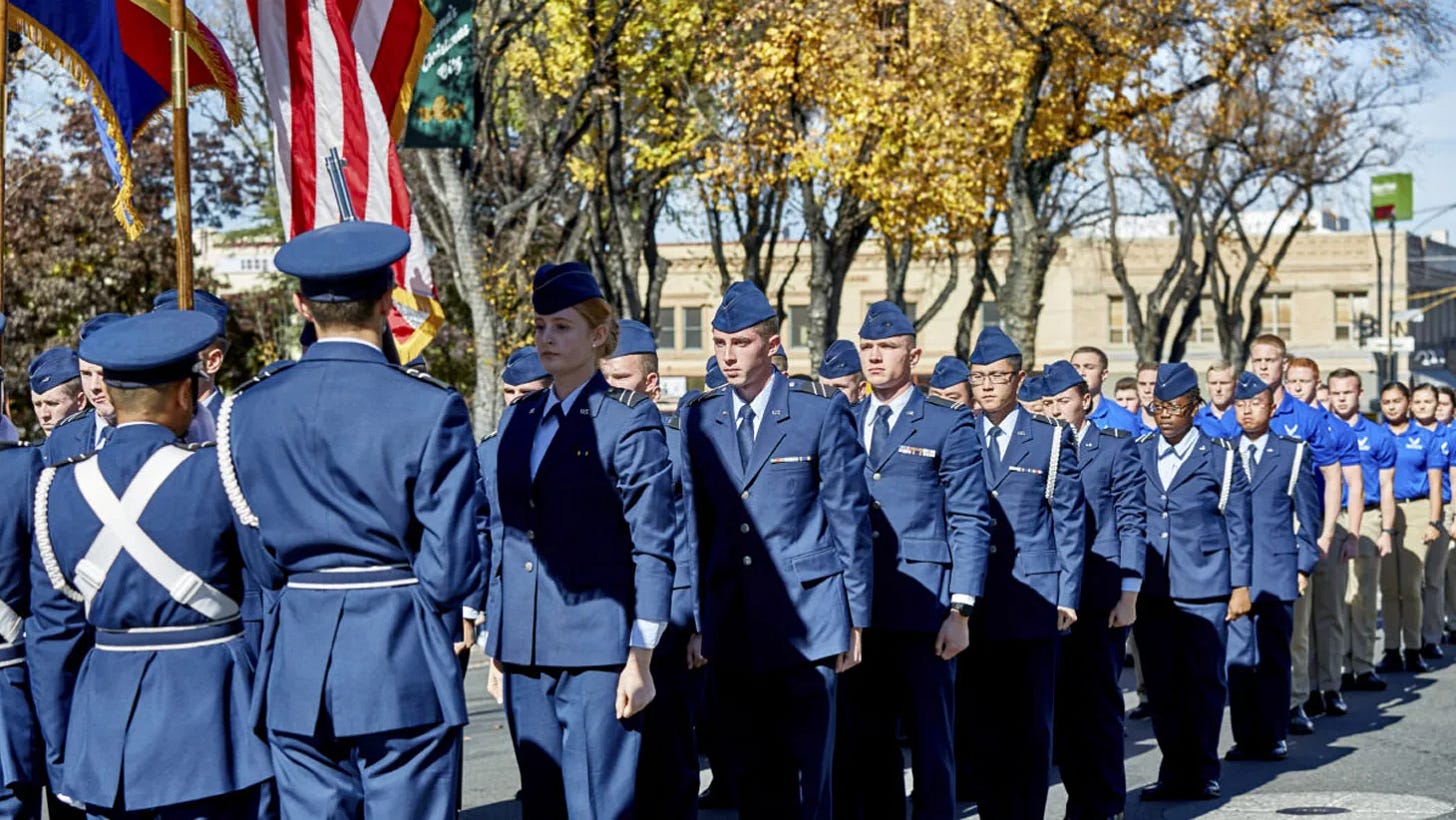
Anti-War Colleges? Good luck finding one.

51 Peacebuilding Think Tanks and Peace Research Groups
David and I talked about his radio (half-hour) show, Talk World Radio
Go there and look at the guests he’s had on since 2012.

Irony of ironies, David had Medea Benjamin on, and they talked on that very first show about the little bitsy drone:

That was more than 13 years ago, and now, drones? On fucking steroids.
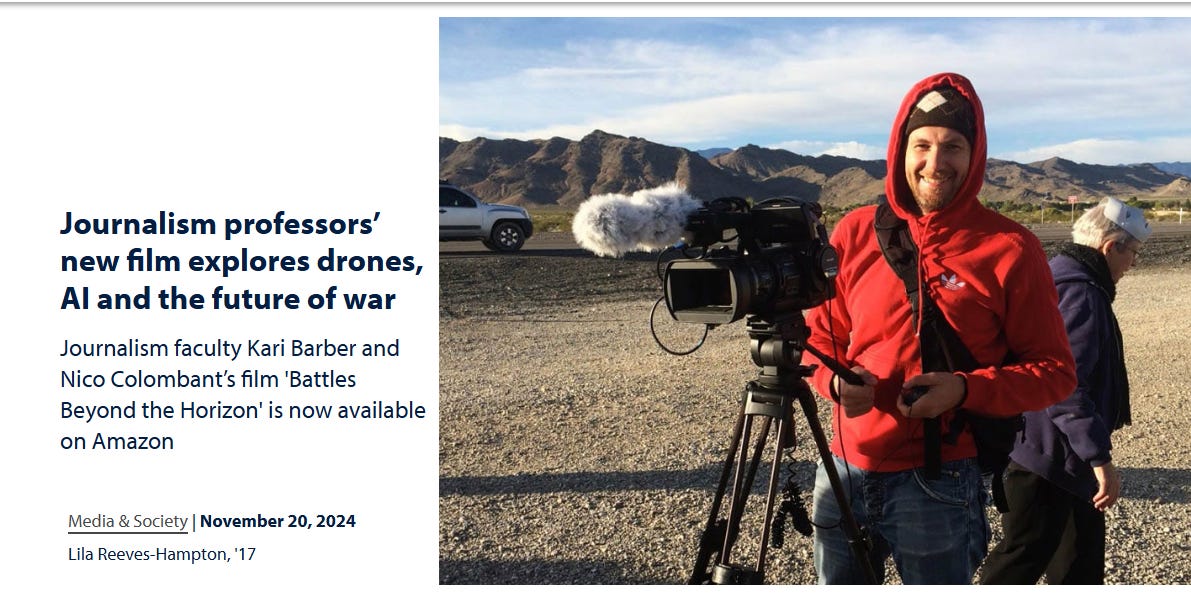
Will humans soon be entirely “out of the loop” for certain U.S. military actions in remote parts of the world? Battles Beyond the Horizon, a documentary by two journalism faculty members, poses this question and explores technology, AI and the future of war.
Reynolds School of Journalism Associate Dean and Professor Kari Barber directed the film alongside producer, cinematographer and journalism senior lecturer Nico Colombant.
Battles Beyond the Horizon is set mostly in the Nevada desert at Creech Air Force Base, about 45 miles outside of Las Vegas. The base is used for training and operation of daily overseas operations of remotely piloted drone aircraft systems with missions across the globe.
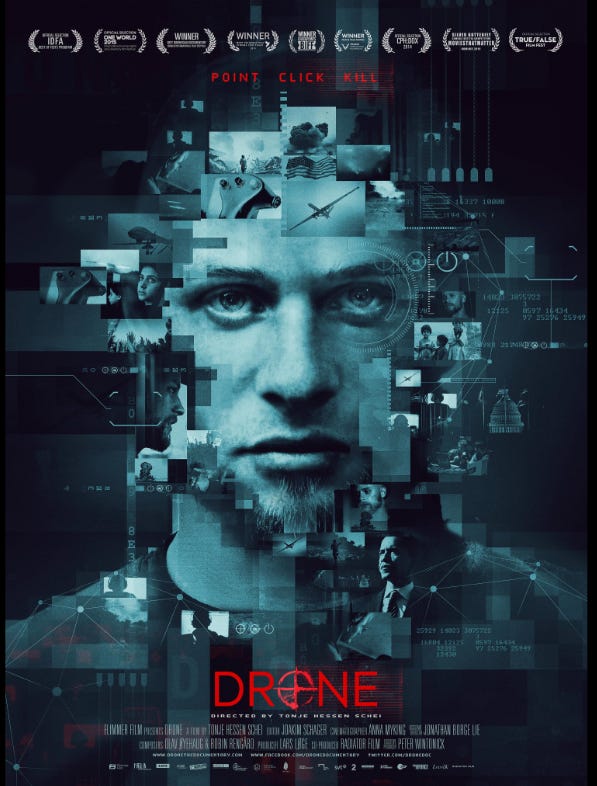
Yeah, quite a long way, baby:



Monsters. Blithely discussing the bug splat and triple taps of the hired guns, drone pilots:

Subject matter expertise was provided by Dr Lindsay Clark, Lecturer in International Relations at the University of Sussex, Major Philippe from the French Air Force currently serving in SHAPE’s Joint Targeting Branch and Mr Ross McKenzie, former Royal Air Force Wing Commander and current Unmanned Aircraft Systems (UAS) Officer at NATO’s Defence Investment Division.
Dr. Clark opened the session by sharing her research on the gendered aspects of drone usage and associated discourses. Her research, informed by former US, British, and Australian drone crews, illustrates the implicit gender categorisation in conflict zones. Terms such as “military-aged males” are often used for potential combatants, while “women and children” are assumed to be civilians, influencing targeting decisions and increasing the risk of misidentifying threats. She highlighted that this ingrained assumption underscores a broader thought process affecting how entire campaigns are constructed and how civilian casualties are perceived.
Dr. Clark examined the gendered language around drone warfare, explaining that drone pilots and crews are often viewed differently than fighter pilots. For instance, references to a “PlayStation mentality” or the idea that drone warfare lacks the physical risks of traditional combat subtly diminish the heroism and dedication of drone operators. This language casts drone warfare as “less masculine” and trivialises the emotional toll on operators. Furthermore, she noted that female drone operators are often portrayed as emotionally unstable, a depiction not commonly attributed to their male counterparts. This gendered expectation not only affects perceptions but also impacts the mental health and retention of personnel, as they may feel less inclined to seek psychological support due to a fear of appearing weak.
Next, Maj. Philippe outlined the technical complexities of drone targeting, emphasising that the term “drone” is overly simplistic. These remotely piloted systems can operate at various altitudes and drop munitions similar to fighter aircraft. He outlined processes such as Positive Identification (PID), Rules of Engagement (ROE) and Collateral Damage Estimation (CDE), each designed to minimise harm to civilians. Four guiding principles – distinction, proportionality, military necessity and humanity – help assess whether a strike is justifiable. In this framework, “collateral damage” is considered legally permissible if it is not excessive in relation to military objectives.
Pattern-of-life analysis, a critical tool used by remotely piloted systems, examine a target’s environment and behaviours to prevent misinterpretations that might lead to unnecessary casualties. However, Maj. Philippe noted that the risk of civilian harm remains, especially when women and children are deliberately placed in harm’s way as a tactic of deception. Common factors leading to targeting errors include cultural misunderstandings, poor analysis, psychological biases and behaviour misinterpretation, making it essential to integrate diverse perspectives, including gender, in the decision-making process.
Major Philippe noted that targeting decisions are traditionally made by the Commander and Legal Advisor (LEGAD), but now often include input from a Political Advisor (POLAD) and Gender Advisor (GENAD). GENADs play an increasingly significant role in targeting boards, contributing insights that can help assess the broader effects of military actions on men, women, boys and girls. This expansion of viewpoints helps commanders consider potential secondary effects, such as the impact of disrupted water supplies or other basic resources on vulnerable groups.
Mr McKenzie challenged the media’s use of the term “drone” which he argued implies an autonomous robot, obscuring the fact that a team of humans is operating the system. He noted that the language choice can deflect accountability, as public perception often associates automation with impersonal, robotic decision-making rather than a crew’s calculated judgment. He instead suggested the use of terms like ‘Unmanned Aircraft System’ or ‘Remotely Piloted Aircraft Systems’.
This human aspect introduces psychological challenges. Mr McKenzie highlighted that pilots and analysts often work long, intense shifts followed by an abrupt transition to their civilian lives at home, a pattern that can lead to emotional detachment. This lifestyle imposes a unique psychological toll.
Another area of concern Mr. McKenzie raised is the rise of ‘swarming’ technology, where multiple drones operate together autonomously. These true ‘swarms’ could change combat drastically, allowing for complex collaborative tactics. He suggested that while many Nations prioritise keeping humans “on the loop” in decision-making, the potential shift toward entirely autonomous combat poses ethical questions and gender considerations that should inform policy as technology evolves.
Looking ahead, NATO’s policy indicates that within a decade, human pilots may no longer fly fighter planes. As drone technology advances, so too must the ethical frameworks and societal perceptions that govern its use. The perspectives shared by Dr. Clark, Maj. Philippe, and Mr. McKenzie underscore the urgent need to examine the gendered dimensions of drone warfare. Integrating gender perspectives into both operational planning and public discourse can protect personnel and help them make more informed decisions that recognise the full spectrum of impacts on combatants and civilians.
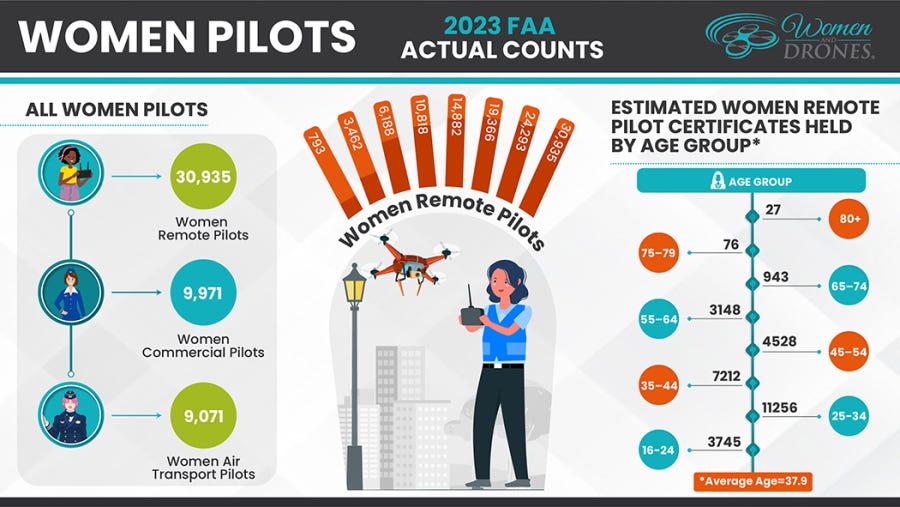
All fucking smiles?
Yemen had to set up a counseling center to help children deal with the psychological trauma of U.S. drone attacks, a Yemeni official told the United Nations Committee on the Rights of the Child this week.
Clinical and forensic psychologist Dr. Peter Schaapveld has previously explained how children in the impoverished country are “traumatized and re-traumatized by drones,” and described one young girl whose “dreams are of dead people, planes and people running around scared.”
Kat Craig, Legal Director of UK-based human rights group Reprieve, stated that Yemeni “President Hadi’s agreements with the US are trumping Yemen’s responsibility to protect its children. Instead of allowing the U.S. to bomb his country to pieces and then setting up a recovery center, President Hadi should listen to his Parliament and stop the drone strikes.”
In December, the Yemeni Parliament called for an end to U.S. drone strikes on the country following a strike that targeted a wedding party and killed a dozen people. Evidence gathered by Reprieve has forced the administration to investigate the strike.
2014 has brought a continuation of U.S. drone strikes on Yemen, with a Yemeni farmer the being the first known civilian casualty on Wednesday.
Baraa Shiban, Reprieve’s Yemen project co-ordinator, wrote in an op-ed this week:
Our President may reassure the U.S. of his support for drone strikes, but he does so in complete contradiction to the Yemeni people’s wishes. This year, two of Yemen’s greatest democratic institutions made this clear. Yemen’s National Dialogue Conference — praised by Obama as a “historic” institution — and the Yemeni Parliament have both voted overwhelmingly to ban the use of drones.
For a country so often divided, this unanimity from Yemen’s key democratic bodies shows the strength of public opinion against drones. But the people’s cries have been met only with more missiles raining down from the skies above. How can we in Yemen build our fledgling democracy when our collective will is ignored by Western democracy’s most powerful proponent?
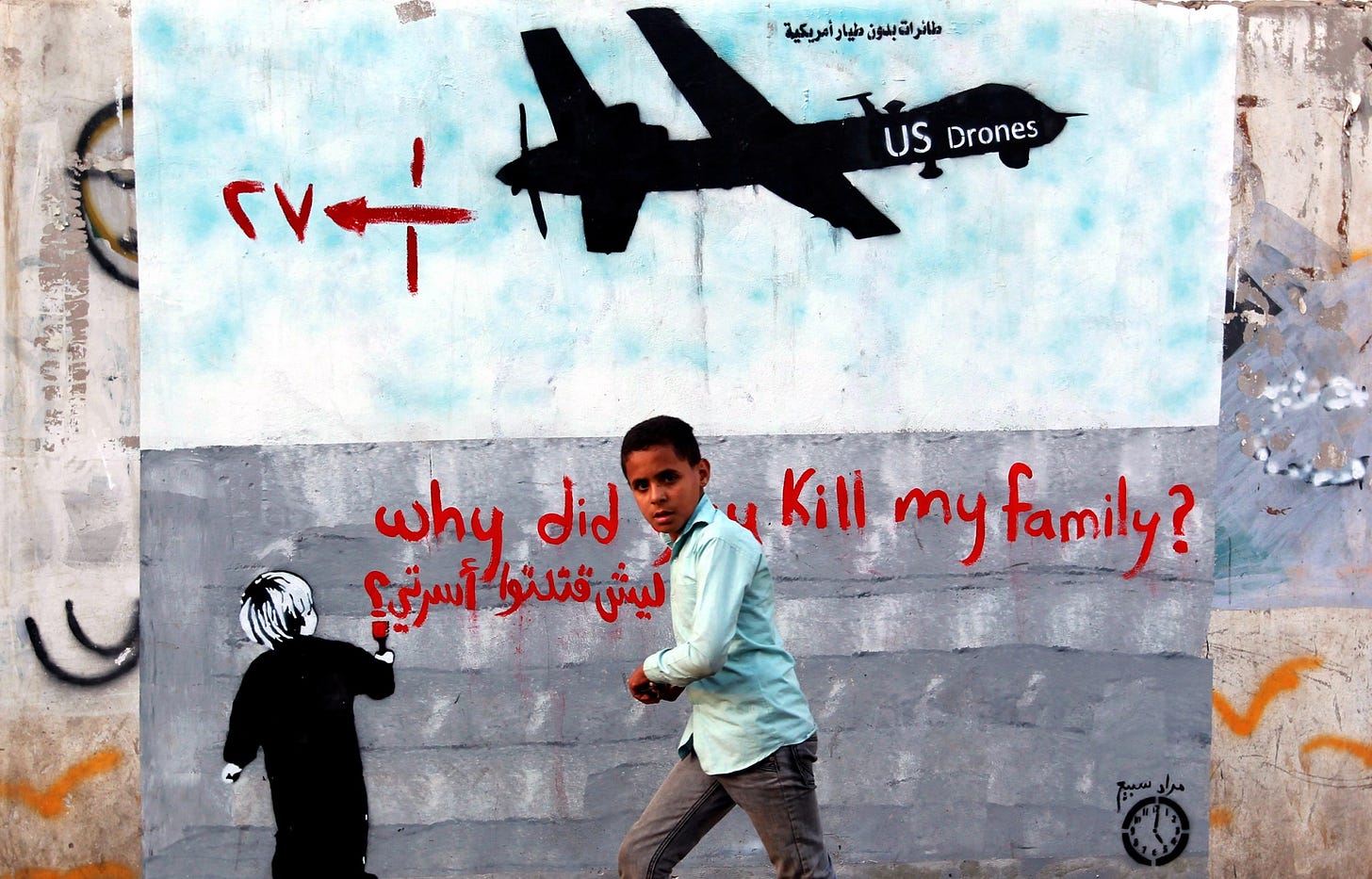
I didn’t get to talk about much of David’s background, growing up back east, even going to school with Ollie North’s daughter. He’s been asked “how did you become a peace activist” a hundred times. You can go read that here:
David Swanson is an author, activist, journalist, and radio host. He is executive director of World BEYOND War and campaign coordinator of RootsAction.org. Swanson’s books include War Is A Lie and When the World Outlawed War. He blogs at DavidSwanson.org and hosts Talk World Radio.
On November 10, 2024, Swanson was awarded the Real Nobel Peace Prize by the Lay Down Your Arms Foundation in Oslo, Norway. Swanson was awarded the 2018 Peace Prize by the U.S. Peace Memorial Foundation. He was also awarded a Beacon of Peace Award by the Eisenhower Chapter of Veterans For Peace in 2011, and the Dorothy Eldridge Peacemaker Award by New Jersey Peace Action in 2022, and a Global Peace Leadership & Excellence Award in 2024.
Swanson is on the advisory boards of: Nobel Peace Prize Watch, Veterans For Peace, Assange Defense, BPUR, Military Families Speak Out, Fields of Peace, and Peace in Ukraine Coalition. He is an Associate of the Transnational Foundation, and a Patron of Platform for Peace and Humanity. He is on the Consultative Council of the SHAPE Project. He is on the International Coordinating Committee of No to War – No to NATO. He is on the Steering Group of Warheads to Windmills.

Here, a long-long look at his memoiric life:
The short version of this is: For some reason I don’t like to accept lies and nonsense from figures of authority, and that leaves me seeing war as the worst thing around.
I’ve been asked a number of times to write chapters for books on “how I became a peace activist.” In some cases, I’ve just apologized and said I couldn’t. For one book called Why Peace, edited by Marc Guttman, I wrote a very short chapter called “Why Am I a Peace Activist? Why Aren’t You?” My point was basically to express my outrage that one would have to explain working to end the worst thing in the world, while millions of people not working to end it need offer no explanation for their reprehensible behavior.

Books books books:
- NATO What You Need to Know (2024). Medea Benjamin and David Swanson. OR Books.
- The Monroe Doctrine at 200 and What to Replace it With (2023). David Swanson. ISBN 979-8-9869811-0-9
- Snippers Saves the World (2021). David Swanson. ISBN 978-1734783704
- Leaving World War II Behind (2021). David Swanson. ISBN 978-1734783759
- 20 Dictators Currently Supported by the U.S. (2020). David Swanson. ISBN 978-1734783797
- Curing Exceptionalism (2018). David Swanson. ISBN 978-0998085937
- War Is Never Just (2016). David Swanson. ISBN 978-0998085906
- War Is A Lie (2010, 2016). Just World Books. ISBN 978-1682570005
- Killing Is Not A Way of Life (2014). David Swanson. ISBN 978-0983083061
- War No More: The Case For Abolition (2013). David Swanson. ISBN 978-0983083054
- Tube World (2012). Illustrated by Shane Burke. David Swanson. ISBN 978-0983083047
- The Military Industrial Complex at 50 (2011). Editor and contributor. David Swanson. ISBN 978-0983083078
- When The World Outlawed War (2011). David Swanson. ISBN 978-0983083092
- Daybreak: Undoing the Imperial Presidency and Forming a More Perfect Union (2009). Sevent Stories Press. ISBN 978-1583228883
- The 35 Articles of Impeachment (2008). Introduction. Feral House. ISBN 978-1932595420
We coursed through many topics tied to economic sanctions being worse in terms of “body counts” than kinetic war.

Today, economic sanctions are generally regarded as an alternative to war. But for most people in the interwar period, the economic weapon was the very essence of total war. The initial intention behind creating the economic weapon was not to use it–economic sanctions were intended to be a form of deterrence. In this excerpt from The Economic Weapon: The Rise of Sanctions as a Tool of Modern War, Nicholas Mulder looks at the history of the use of economic sanctions in wartime and elaborates on their effectiveness and consequences.
Can war be banished from the earth? Throughout modern history, world peace has been a powerful ideal. It has also been one of the most elusive. Each major war produced its share of cynics as well as visionaries. Pessimists saw war as an inescapable part of the human condition. Optimists viewed growing wealth, expanding self-government, and advancing technology as drivers of slow but steady moral progress. This veering between hope and desolation took on a new urgency after the unprecedented destruction of World War I. The victors created a new international organization, the League of Nations, which promised to unite the world’s states and resolve disputes through negotiation. The collapse of the global political and economic order in the 1930s and the outbreak of a second world war have made it easy to dismiss the League as a utopian enterprise. Many at the time and since concluded that the peace treaties were fatally flawed and that the new international institution was too weak to preserve stability. Their view, still widespread today, is that the League lacked the means to bring disturbers of peace to heel. But this was not the view of its founders, who believed they had equipped the organization with a new and powerful kind of coercive instrument for the modern world.
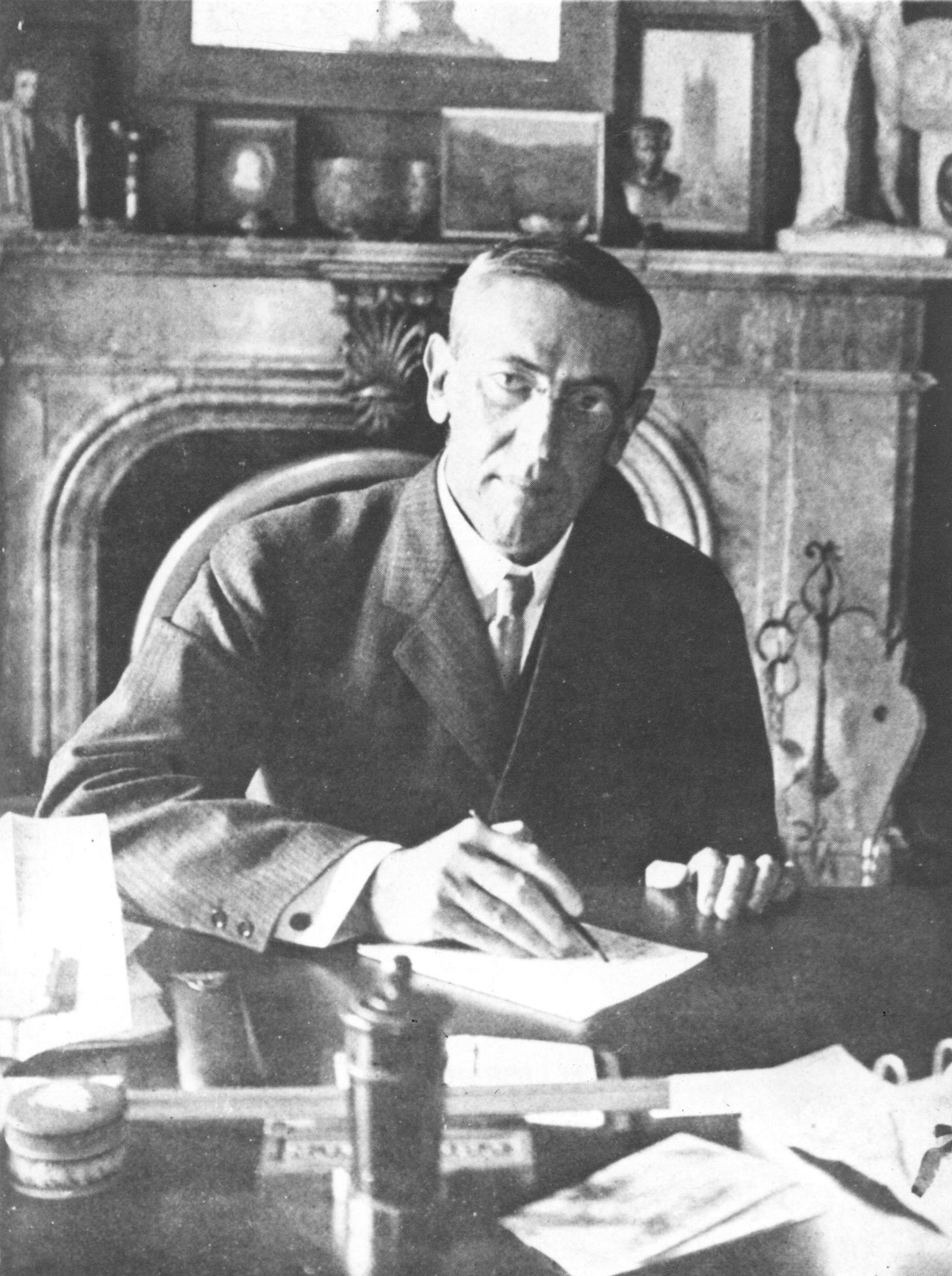
That instrument was sanctions, described in 1919 by U.S. President Woodrow Wilson as
“something more tremendous than war”: the threat was “an absolute isolation . . . that brings a nation to its senses just as suffocation removes from the individual all inclinations to fight . . . Apply this economic, peaceful, silent, deadly remedy and there will be no need for force. It is a terrible remedy. It does not cost a life outside of the nation boycotted, but it brings a pressure upon that nation which, in my judgment, no modern nation could resist.”

As a pacifist, David is consistent on why war against Israel would fail humanity, let alone Gazans, on a grand scale:

Here’s David:
But here’s the key question. What the bloody hell would I recommend instead? I would recommend two types of things, both difficult and with no guarantee of success, but with a significant chance of success. One type of thing is stuff that has not been tried yet. The other is vastly more of stuff that has been tried for years now. The war-as-last-resort crowd always rely on the notion that even a token effort, much less a major one, at something other than war makes war the only option. We’re about to hear, for example, that peace negotiations have been tried and failed for Ukraine, even as neither side proposed to ever compromise in the slightest and the neutral arbiter in the White House promised to keep the weapons flowing to one side. People have made heroic efforts for peace in Gaza. People are exhausted from all those efforts. But some of those efforts have worked and could be multiplied a-thousand-fold. Countries and companies have been forced to divest and to stop arming Israel, and more could be. Media outlets have been forced to convey bits of reality, and public opinion has swung dramatically. These facts do not make up a rosy, happy, hopeful picture. They’re sad little semi-wins for a team having a record-bad season. But they are what you can build on. If one dock can block shipments, all docks can. If one pundit can recognize a genocide years too late, all can. If one government can BDS Israel and its suppliers, all can. If a few aid ships can be sent, hundreds can. If some governments can commit to arresting Netanyahu, more can. Nobody’s proposing we give up on the climate struggle and join the people shooting guns at storms; and that struggle has been going a lot longer than this one.
But what hasn’t been tried yet? Of the thousands of tactics of nonviolent activism, most have of course not been tried. But the key tool especially relevant here is UNARMED civilian defense. Here is a leading expert proposing just that. Please read his proposal carefully. One minor point: he quotes Francesca Albanese at greater length than does the pro-militarism paper discussed above, which claims without evidence that she supports “military intervention.”
Has exactly what is needed here been done before with Unarmed Civilian Defense? No. But it has not yet been tried here either. War is NOT the last resort. Unarmed action builds on a stronger success record than armed “interventions” or armed “peacekeeping.” It also has the following interesting advantage over “military intervention.” The more we put into unarmed civilian defense, the more likely it is to succeed (right up to the extreme in which millions of people are involved and success is guaranteed), whereas the more we put into escalating the war with an “intervention,” the more likely the war is to do more damage (right up to the extreme of killing all life on Earth).
Anything countering the genocide and planned starvation and eco/scholastic/frat/culture/ cide of the Jewish State of Israel would be an act of war. They board sailboats with a few provisions in international waters.
But here’s the thought experiment:
Naval boats with a container ship or two just heading to Gaza FILLED with construction equipment, portable hospitals, drip irrigation food growing systems, medicines, and more.
An international force, and if a navy ship is used to escort the supplies, then so be it. Show via video that the cargo is peaceful means cargo, and alas, just head to Gaza.
We need a massive Dunkirk, but way more sophisticated and programmatic and LARGE and all encompassing:
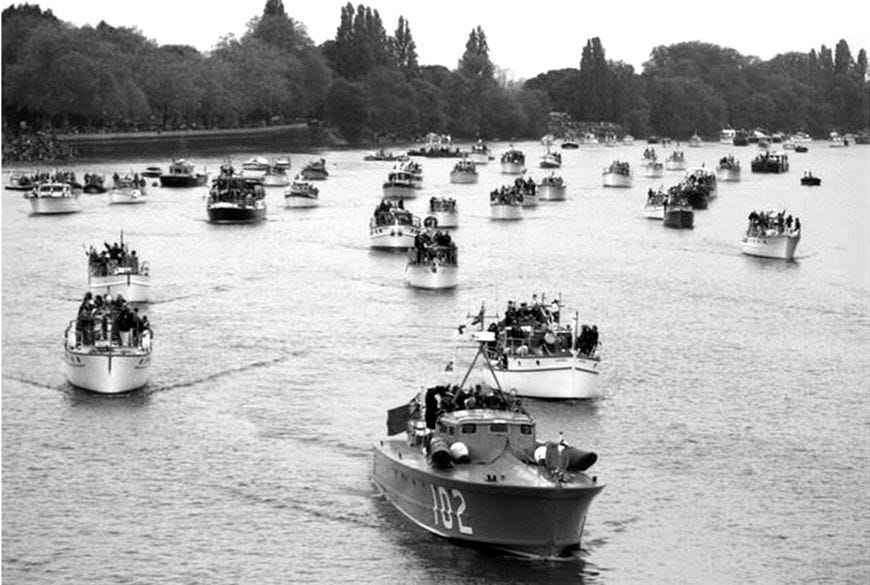


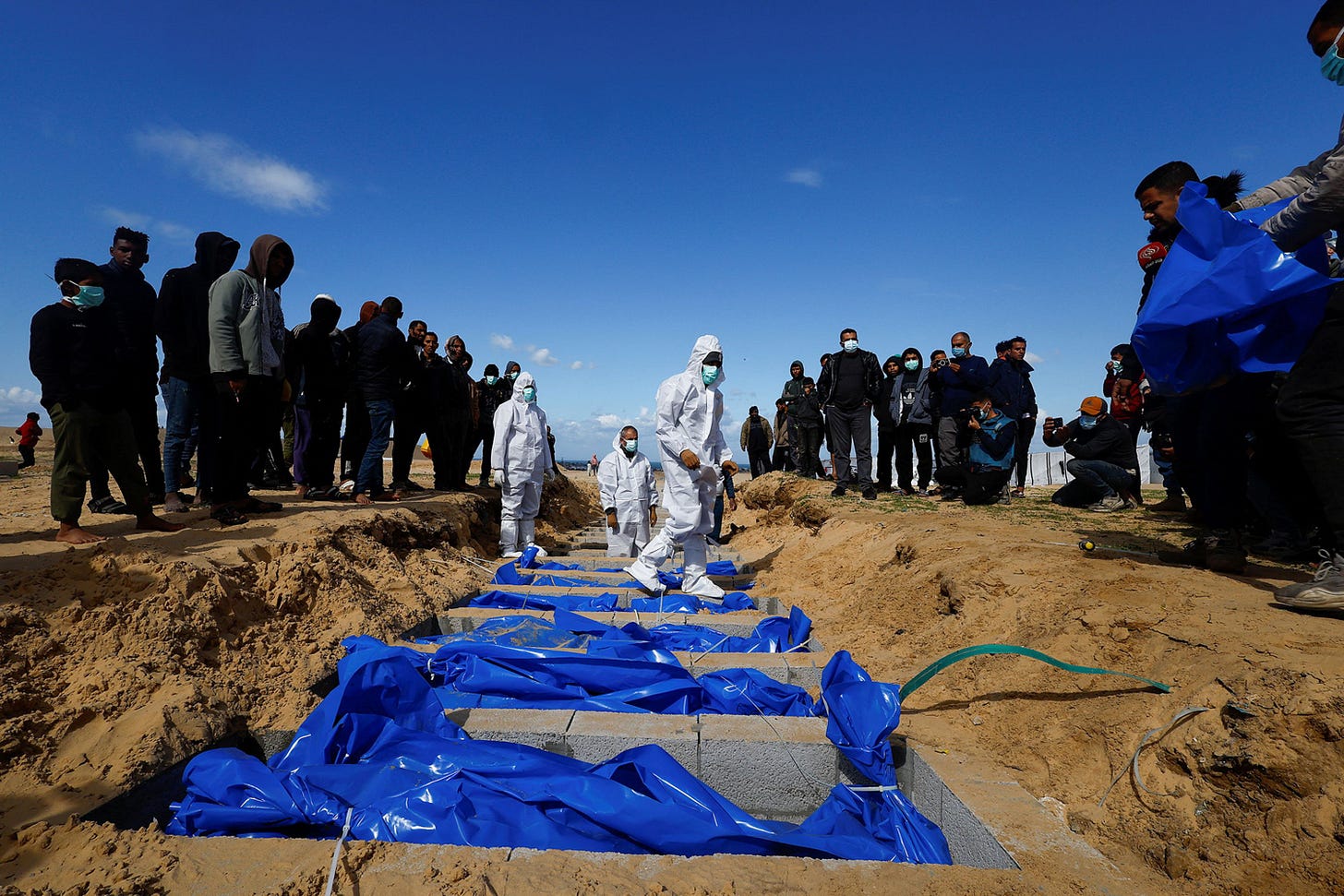

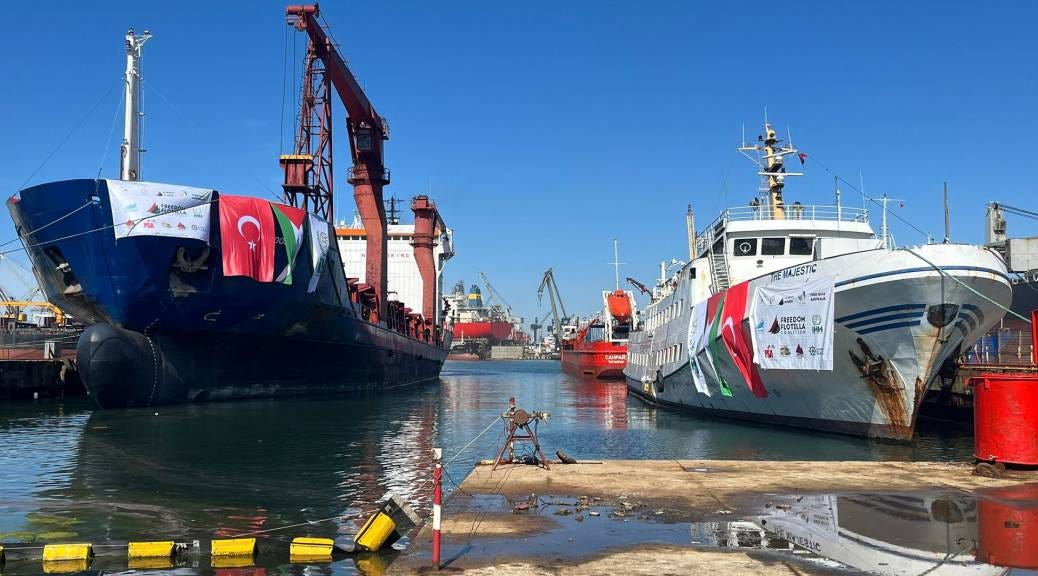

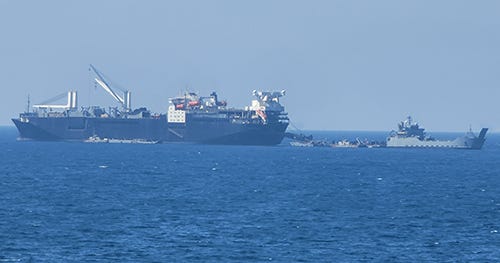
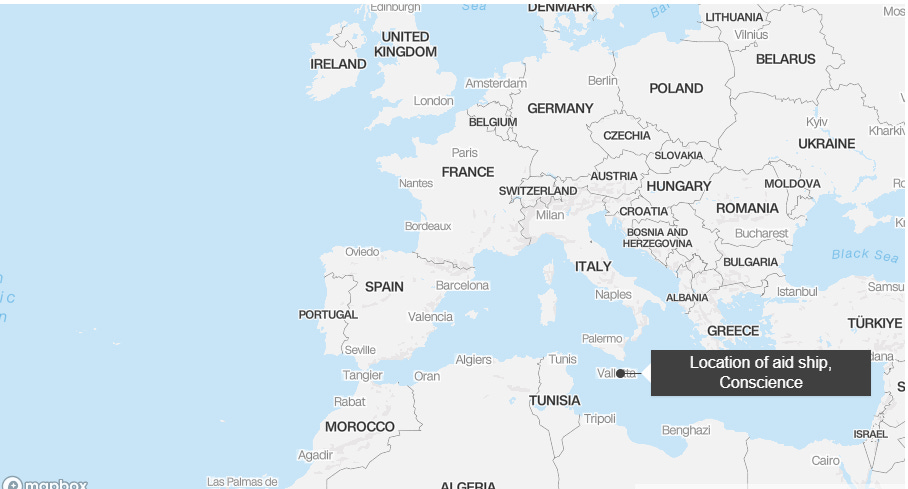
Fuck Israel: Flood the shores of Gaza with AID and AIDES. Flood the shores of Gaza with a thousand ships!
While an exact, precise number is unavailable, maritime traffic analyses suggest over 3,000 vessels of various types are typically in the Mediterranean Sea at any given time. The Mediterranean is a very busy waterway, handling a significant portion of global shipping, but the exact total fluctuates daily and includes commercial cargo ships, ferries, fishing vessels, and yachts.
Key factors and data points:
- High Traffic:The Mediterranean Sea is a major international shipping corridor, experiencing high levels of vessel traffic daily.
- At Any Given Time:Studies show more than 3,000 vessels are often present, indicating substantial continuous activity.
- Diverse Fleet:The vessels include large container ships, tankers, ferries, and smaller recreational yachts, contributing to the overall count.
- Yachts:A significant number of yachts, particularly large ones over 30 meters, are also present, with a large concentration on the French Riviera during the summer months.
Make this a peaceful priority, then, World Without War:
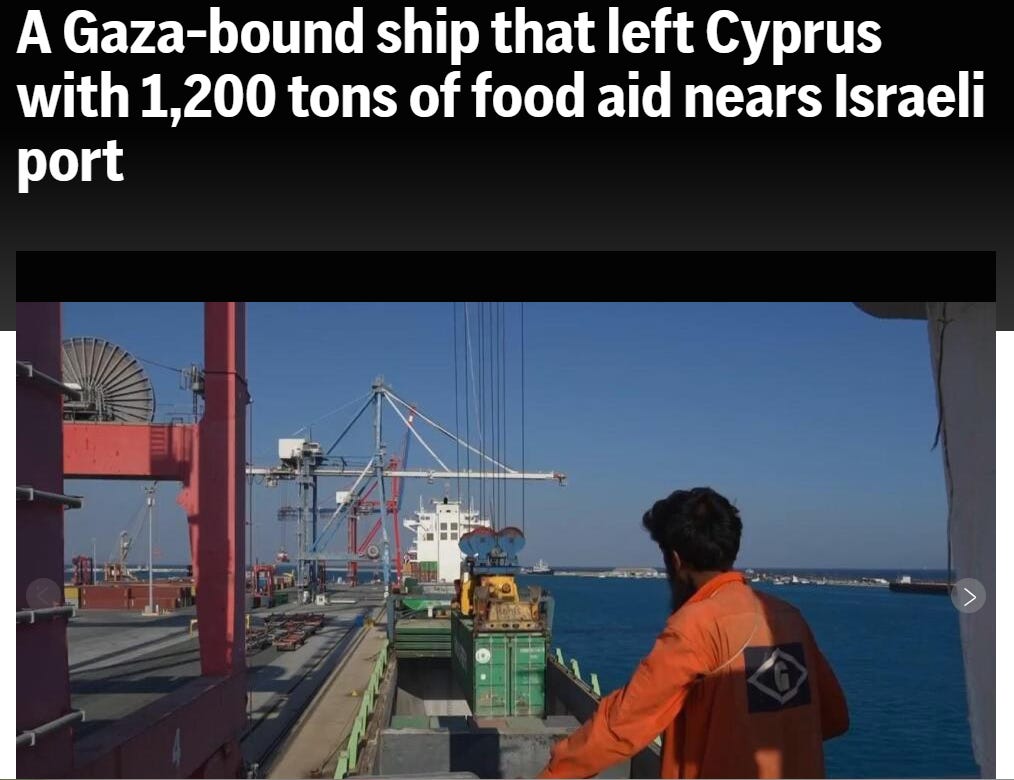
Some 700 tons of the aid is from Cyprus, purchased with money donated by the United Arab Emirates to the so-called Amalthea Fund, set up last year for donors to help with seaborne aid. The rest comes from Italy, the Maltese government, a Catholic religious order in Malta and the Kuwaiti nongovernmental organization Al Salam Association.
REPARATIONS!

Resistitution:
This post is the conclusion of a three-part series: What Will Gaza Become After Genocide? Using the Counterfactual Method to Evaluate Three Post-Genocidal Futures. You may access Part 1 here, where I argued that the genocide Israel is perpetrating against the Palestinians is central to the zionist ethos which, like other settler-colonial movements, seeks to remove the native from coveted lands. In the second part, available here, I explore a scenario where Europe actually complies with international law. As many have cautioned, even European legal compliance would leave Palestinians at risk, where rights are affirmed without enforcement, and violations recognised but not remedied. I turn now to a Palestinian Freedom Dream.
What Will Gaza Become After Genocide? Restitution, Reparations, and Renewal (Part 3)
By August 2025, the world was in agony as Israel engineered the starvation of the people of Gaza, images of backbones and protruding ribs breaking hearts and exposing zionism’s final descent into barbarism. UN agencies confirmed that Gaza faced devastating food scarcity, having breached two of three famine thresholds. Hundreds of thousands of children faced acute malnutrition, their bodies withering, waiting in queues under the scorching sun for hours for a single meal, only to be gunned down by Israeli soldiers posing as humanitarians. At the same time, settlers in the West Bank capitalised on the chaos, burning orchards and poisoning wells, seeking to dismantle Palestinian agriculture destroying, among others, Hebron’s only seed bank. By the end of the year, the grotesque irony was inescapable to everyone, even liberals: the heirs of the people starved in German concentration camps were replicating Nazi tactics with remarkable determination. It was this obscenity—infants dying of thirst and parents boiling weeds to survive—that finally wrecked the myth of zionism as a moral project, with any claims to virtue crushed under the rubble of Gaza’s bombed hospitals, schools, bakeries, and bodies. It was in this breaking moment that two figures plotted an exit.
It began with a balled-up tissue, casually tossed into a prison cell. Marwan Barghouti, entering his third decade in captivity, unfolded the note to find a plea from Ehud Olmert, Israel’s former prime minister, then a political outcast: “The occupation has poisoned us both. Let us imagine its end.” Olmert, once unapologetic about settlements, led a clandestine coalition of dissidents—historians like Omer Bartov, legal scholactivists like Neve Gordon, and even former Shin Bet agents who’d grown disgusted of their own shadows. Their message was simple: zionism had reached its natural conclusion—a death cult devouring its own. As did others, Olmert recognised that two-state solution was dead and buried. Even the West’s belated push for Palestinian statehood could not resuscitate it; the only viable path that remained was a single state, built on return, restitution, and cohabitation.
Barghouti was rightly sceptical, wondering if this was another ploy, a factional struggle between fascist zionism and (il)liberal zionism. Perhaps the only thing ringing louder than his alarm bells was the requiem playing in the background, heralding the death of Palestine’s present and its future. He decided to take a chance, responding cautiously but hopefully.
What followed were months of encrypted messages, covert meetings in Cape Town and Beijing, and a series of trade offs, each more painful than the last. In August 2026, news of the secret talks broke, striking Palestinian and Israeli societies—and much of the world—like a sledgehammer. Eager for such a moment, a global solidarity movement erupted like wildfire: BDS escalated to full scale embargoes; ports turned away Israeli ships (some dock workers sunk them); Hollywood stars abandoned Marvel. Karim Khan, cleared of all suspicion earlier that year, immediately requested arrest warrants for most of Netanyahu’s cabinet (the investigations into the support offered by Starmer, Macron, and von der Leyen are ongoing). Zionism had become so addicted to land theft that it could no longer hide behind propaganda, swiftly collapsing under the weight of disgrace and shame brought about by the Great Famine of 2025. The number of Israeli deserters multiplied as they sought refuge from accountability for scores of dead children (alas for them, the world would not overlook the brutalities inflicted and many dual citizens ended up in national prisons). In Gaza, ceasefires held not because of diplomacy, but because the Americans, alone, could no longer sustain the armament supply chains.
On the day the walls fell, it was not governments but grandmothers who led the way. Palestinian elders crossed checkpoints clutching rusted keys and deeds from 1948, while Israeli activists used construction cranes—once tools of settlement—to dismantle the wall. Domestic support for the settlers, already on life support, collapsed once they began shooting fellow Israelis. In Haifa and Jaffa, families returned to homes now occupied by third-generation Israelis; some settlers fled to Canada and Australia, much as South Africans did when that state was liberated from their version ethno-chauvinism. Others stayed, forced to vacate the stolen homes they previously claimed as their own. [Some years later, Daniella Weiss was found hiding in a basement in London, and was swiftly extradited to Palestine to stand trial for her instigation of that final massacre.] The Knesset was dissolved, substituted by a transitional council comprised of Palestinians from the West Bank, Gaza, and East Jerusalem, and several Israeli anti-zionists as well (returning Palestinians would be eligible for office once they completed their naturalisation process). Barghouti and Olmert reached a compromise with Meshal: Hamas would disarm in exchange for the proscription of Otzma Yehudit, Hatzionut Hadatit, and Noam and the handover of Ben-Gvir, Smotrich, and Moaz to the Hague where they would join Netanyahu and Gallant to stand trial for their reign of terror.
The prisoners came next. Raised to the sound of cell doors and fluorescent hum, thousands emerged from Israeli jails, blinking at the sun, their anxiety broken by embraces and endless unspent love. Flags were fleeting, as were anthems and chants—instead, the air was filled with voices and screams and laughter as they discovered one another, some for the first time. Zionism’s greatest fear had been realised: Palestinians survived while zionism was on its last leg.
In al Quds, Palestinian and Jewish youth scrubbed racist graffiti from the Old City walls; in Gaza, fishermen launched boats unchained by naval blockades. The new parliament, when it convened, did not debate “peace” but land rights. Land commissions documented thefts dating back to 1948; reparations were paid in stolen orchards and the rebuilding of demolished villages. The two-state solution was archived as a footnote, replaced by a single democracy stretching from the river to the sea—not as a slogan, but a legal fact. Israeli settlers, at least those who stayed, were granted amnesty if they surrendered their rifles, testified about the crimes they committed (murder, rape, and famine were excluded), and provided adequate reparations. Those who did, now queued for Palestinian passports, their birthright of supremacy dissolved like the passbooks of apartheid South Africa.
Zionism died as all ethno-chauvinist projects die—when the people marked for elimination hold on, when the ideology blushes before it own propaganda, and when the world runs out of excuses to look away. When Barghouti and Olmert signed the new constitution, the latter quoted a Hebrew prophet: “You have been told what is good: to do justice, love mercy, and walk humbly.” Barghouti, for his part, offered a Shona proverb: “The ax forgets; the tree remembers.” Each phrase hung in the air, epitaphs for dead ideologies and its victims, a dual reminder that hierarchies are always on borrowed time.
Today, the checkpoints have been reconstituted as museums, memorials for those who did not see Palestine’s liberation. Settlements, no longer fearsome, have been renamed in honour of martyrs and are now being desegregated. While records of the famine still shock the soul, it is now taught not only as a human tragedy but as both reckoning and turning point. Zionism, you might say, learned a key lesson before its demise: no people can be caged forever.

*****
Listen to David and Me as we course through some sticky questions of peace and peace activism, sanctions, and the limits of war but the power of the war lords, WALL Street, City of London, Brussels and Switzerland and the Emerites.

SCALE this up for 2 million in Gaza and Palestine.
In 2011 a documentary called Remote Area Medical followed Remote Area Medical — RAM® to a clinic in Bristol, Tennessee. The documentary focuses on RAM’s patients and what services they need from the RAM Clinic. This award-winning documentary is now streaming for FREE on Tubi.
[ https://tubitv.com/movies/377076/remote-area-medical?start=true ]
The documentary follows many patients on their treatment journey as they attend the clinic. Starting in the patient parking lot, the documentary crew talks to patients that have been sleeping in their cars for days for the opportunity to be seen by medical professionals and receive care for free. Many of these patients brought food and provisions to allow them to stay in the parking lot until the clinic opened at 6 A.M. on Friday morning. They chose to stay in the parking lot to guarantee their place in line because RAM Clinics are first-come, first-served until the clinic reaches capacity.
The cost of healthcare is debilitating for many, and they are forced to go without necessary medical, dental, and vision care. In the documentary patients discuss the difficulties affording the care they need because they do not have health insurance or if they do have insurance, they cannot afford the insurance’s co-pay.
“The thing that weighs on me the most is, we have people in desperate need within our borders. Remote areas and medicine? We don’t have to go too remote,” said one RAM Volunteer.
One older patient said to one of RAM’s volunteer providers that he had not been to a doctor since he was a teenager; this patient did not know that he had been experiencing high blood pressure. Others had not gotten a new pair of glasses in as many as seven years, and their inability to see was impacting their ability to work.
The patient stories in the documentary show how prevalent the need for free healthcare is throughout the country. No matter where RAM goes in the U.S., we find patients in need of our services. The clinic in Bristol, Tennessee served more than 2,000 patients, providing more than $606,000 worth of free care in three days.
“These patients are real. Their needs are real. It’s a reminder of the people in America who have no access to the system,” a RAM Volunteer said.
The documentary also shows the emotional connections that are often formed between the patients and the healthcare professionals at RAM Clinics. One dentist shared that seeing patients crying from the pain relief of having an abscessed tooth removed made her cry as well. For her and many others, it’s hard to hold back tears while witnessing patients finally receive the desperately needed dental care they have gone without. Their relief and gratitude inspire volunteers to return time and again.
This documentary covers a RAM Clinic from waiting in the parking lot to taking down tents and loading them back into the trucks, and nearly everything in between. For a more in-depth look into a RAM Clinic and the impact it has on people’s lives, click here to stream Remote Area Medical for free.
Since the documentary aired RAM has been able to help thousands more patients — read Max’s story to see how RAM Volunteers and community members came together to help a high school student in need.

This post was originally published on Dissident Voice.